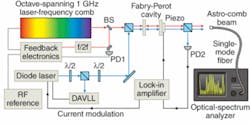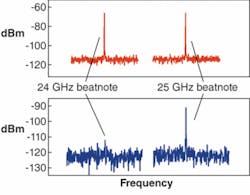Ultrafast lasers: Frequency combs refine Doppler search for distant planets
PETER FENDEL AND LORI HOWE
The ability to calibrate spectrographic systems with the latest gigahertz-repetition-rate ultrafast modelocked lasers is expected to improve the wavelength-calibration precision of Doppler-velocity measurements by a factor of 60, allowing astronomy researchers to detect Earth-size planets in other solar systems (exoplanets). The sixtyfold improvement will bring the accuracy of the measurements to the theoretical precision limit of the Echelle spectrograph used in astronomical measurements (for a description of the principle of the Echelle spectrograph see http://en.wikipedia.org/wiki/Echelle_grating).
Current technology only detects planets that are five Earth masses or larger in Mercury-like orbits around stars of similar size to our Sun. An emerging “astro-comb” technology, however—enabled by recent advances in Ti:sapphire ultrafast lasers and the optical-frequency comb work of Nobel Prize Laureates Ted Hänsch and John Hall—may boost commercially available technology well beyond current limitations.
Finding planets via the Doppler effect
The search for exoplanets using Doppler spectroscopy involves capturing light from distant stars and monitoring periodic changes in the spectrum as the star and planet move about their common center of mass. The Doppler effect causes an observer to see either a blue shift if the emitting object is moving toward the observer or a red shift as the emitter moves away (see Fig. 1). The large differences in mass between parent stars and orbiting planets in distant Earth-like systems are expected to yield very small Doppler shifts, detectable only through very sensitive instruments.
In addition, the observation period must correspond to the period of an actual orbit, requiring the equipment to operate stably for weeks, months, or even years, depending on the star-planet system under observation. To meet and maintain the necessary levels of accuracy and stability, the measuring devices—usually Echelle spectrographs in combination with large telescopes—require highly precise and repeatable methods of calibration. Finding ideal calibration sources for such applications poses technical challenges, however, because the reference spectral lines must be resolved from each other, have uniform spacing, cover a broad optical range (typically thousands of angstroms), and exhibit uniform intensity; in addition, they must remain stable over long periods of time.
Cost-effective and simple calibration sources include the simple iodine cell and the thorium-argon hollow-cathode lamp, but both sources have significant limitations. Iodine cells have limited spectral bands in the desired red and near-IR spectral regions. Thorium-argon lamps give a broader spectral coverage, but also yield spectral lines whose intensity and spacing vary greatly over the optical range, change with time, and are not constant from lamp to lamp at the level of wavelength-calibration precision necessary for Doppler-shift-based exoplanet searches.
These technologies provide a wavelength-calibration precision that allows a velocity sensitivity on the order of 60 cm/s—which is insufficient for detecting planets on the order of a single Earth mass and is well below the optimal photon-limited wavelength-calibration precision for current Echelle-spectrograph technology (equal to a Doppler-shift precision of 1.0 cm/s).1 These and other technical requirements have led to the testing of optical-frequency combs as potential calibration sources for astronomical spectrographs.
An optical-frequency comb consists of a series of spectral lines evenly separated in frequency space and is easily generated using a modelocked ultrafast laser that puts out a series of pulses evenly spaced in time. The laser repetition rate determines the spacing between individual comb modes. A frequency comb is not completely described by the spacing between the spectral lines, however. A second degree of freedom—the so-called carrier-envelope-offset frequency (fceo), which determines the absolute position of the comb in the frequency space—can be easily measured when the laser spectrum covers one optical octave (such that f and 2f frequency components are present in the spectrum).2
Technical considerations
The ideal reference is actually a frequency comb that matches the instrument functions of the spectrograph with a resolving power from about 103 to 105, corresponding to mode spacing from 5 to 400 GHz. Combined with the need for an octave-spanning spectrum, this requirement presents a serious challenge.
Existing setups most often broaden the laser spectrum to the required bandwidth by the use of photonic-crystal fibers. Nonlinear effects within the fibers result in spectral broadening beyond the normal Ti:sapphire range, however, so this technique, although useful, poses limits, particularly in terms of long-term stability.
Recently developed ultrafast-laser technology overcomes these limits, however, with spectra ranging from visible to optical-communication wavelengths resulting from the so-called self-phase modulation in the gain medium itself.3
In addition to capitalizing on intracavity self-phase modulation, recently developed laser designs also rely on advanced mirror technology within the laser cavity to generate octave-spanning optical-frequency combs at repetition rates of more than 1 GHz immediately out of a Ti:sapphire oscillator.4 The high fundamental repetition rate enables straightforward and relatively low-loss multiplication by mode filtering. The octave-wide spectrum allows for self-referencing; for instance, phase-locking the laser to a primary or secondary frequency standard while still covering a wide range of astronomically interesting spectral lines.
Gigahertz astro-comb technology
To create the first astro-comb based on a filtered laser-frequency comb, researchers from the Harvard-Smithsonian Center for Astrophysics (CFA; Cambridge, MA) and the Massachusetts Institute of Technology (MIT; Cambridge, MA) used a 1 GHz octave-spanning Ti:sapphire laser developed at MIT to demonstrate a 40 GHz astro-comb by external filtering with a Fabry-Perot filter.5, 6 The octave-spanning 1 GHz laser has been commercialized by Menlo Systems (Newton, NJ); one of those lasers will be used as a calibration source in Doppler spectral exoplanetary exploration at the Multiple Mirror Technology (MMT) telescope in the Fred Lawrence Whipple Observatory on Mount Hopkins (Amado, AZ).Each “tooth” in the 1 GHz source comb is stabilized using a low-noise frequency synthesizer that can be referenced to an atomic clock (see Fig. 2). A Fabry-Perot etalon then filters the stabilized source comb to increase the line spacing to 37 GHz. An injected diode-laser signal locked to the rubidium D1 line by a dichroic atomic-vapor laser lock stabilizes the Fabry-Perot cavity.
The output spectral bandwidth of an astro-comb spans about 1000 Å, and each comb line produces about 10 to 100 nW of power. To aid calibration and to achieve the 1 cm/s photon-limited sensitivity of astronomical spectrographs, the free spectral range of the Fabry-Perot cavity can be adjusted to change the line spacing (see Fig. 3).The Harvard and MIT researchers will be testing an astro-comb wavelength calibrator based on the Menlo Systems frequency comb at the MMT on the telescope’s so-called Hectochelle (an optical-fiber-fed multiobject spectrograph). A 150 Å bandwidth around an 8500 Å wavelength on this spectrograph will be used to study dark matter and other phenomena in globular clusters. The researchers expect the astro-comb wavelength calibration to operate throughout the typical 10-hour duration of observations using this spectrograph.
The first actual astronomy experiments using an astro-comb for exoplanetary exploration are scheduled to take place on the HARPS-NEF (High-Accuracy Radial-velocity Planet Searcher of the New Earths Facility) spectrograph, a device that Harvard researchers will begin to construct next year at the William Herschel Telescope (La Palma, Canary Islands) and hope to complete by 2010. The possibility of frequency-doubling the source comb could further enable leading-edge experiments such as directly measuring the accelerating expansion of the Universe (Sandage-Loeb test). Significant experimental improvements provided by such a comb would allow for a three-year experimental observation period, which can be compared to the more than ten years of experimental observations needed to obtain similar data using current technology.
REFERENCES
1. Murphy et al., Mon. Not. R. Astron. Soc., 000, 1, (2007).
2. Udem et al., Nature 416, 233 (2002).
3. R. Ell et al., Opt. Lett. 26, 373, (2001)
4. Kärtner et al., J. Opt. Soc. Am. B 18, 882, 2001.
5. Li et al., Nature 452, 610 (2008).
6. Benedick et al., CLEO Europe (2007).
Tell us what you think about this article. Send an e-mail to [email protected].
PETER FENDEL is CEO and president of Menlo Systems, 69 Stickles Pond Rd., Newton, NJ 07860; e-mail: [email protected]; www.menlosystems.com. LORI HOWE is a freelance science writer.


